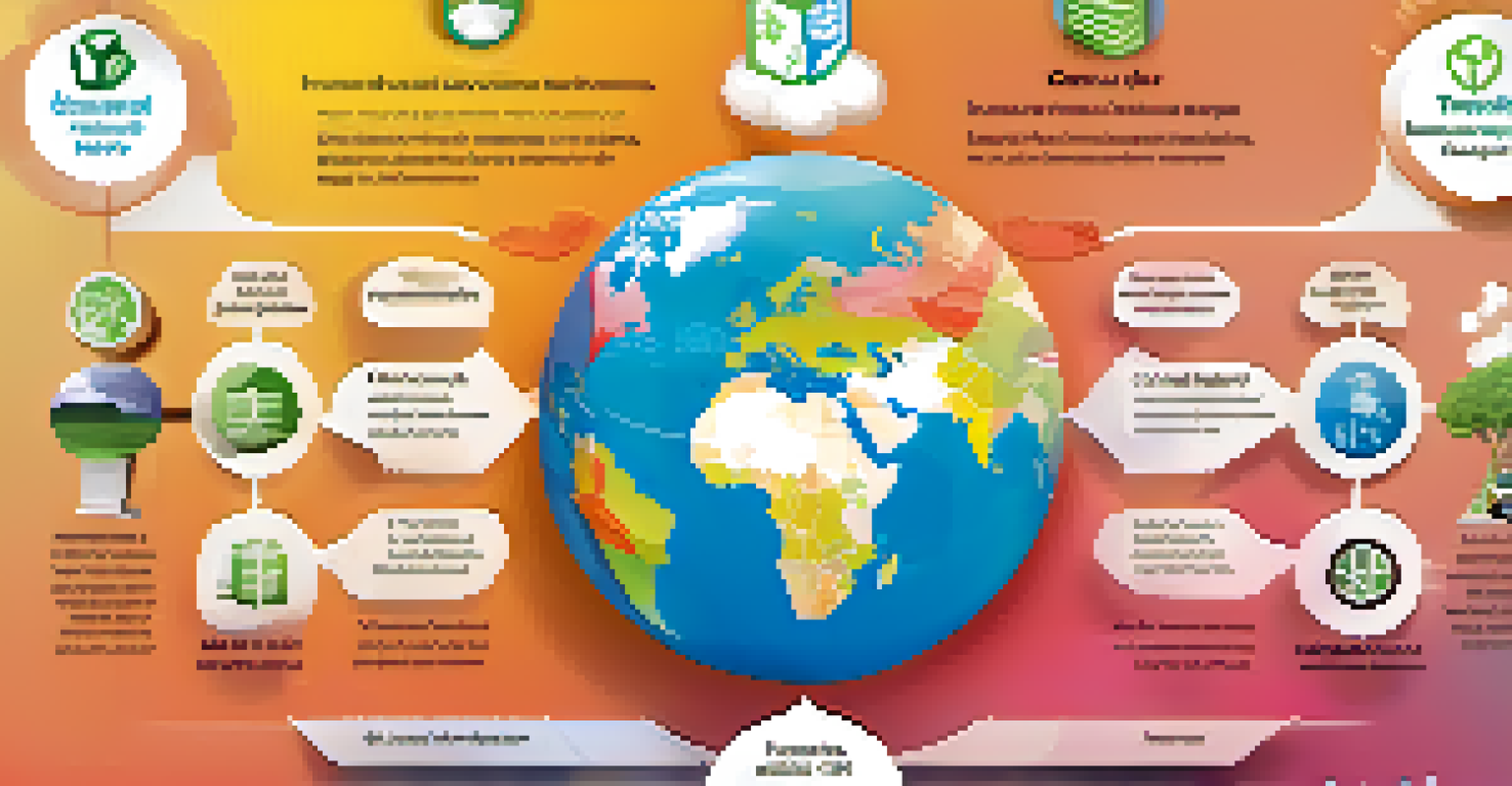Building an ESG Portfolio: Key Considerations and Tips

Understanding ESG: What It Means for Investors
ESG stands for Environmental, Social, and Governance, and it’s become crucial for investors today. Think of ESG as a checklist that helps you evaluate how a company manages risks and opportunities related to these three pillars. For instance, a company focused on reducing carbon emissions would score well on the environmental front. By understanding ESG, you can align your investments with your values while potentially enhancing your long-term returns.
Investing in sustainability is not just a trend; it’s a responsibility that every investor must take seriously.
Investors are increasingly recognizing that companies prioritizing ESG criteria often demonstrate resilience and lower volatility. This is because such companies are better equipped to handle regulatory changes and reputational risks. For example, businesses that invest in sustainable practices may be less likely to face backlash from consumers concerned about climate change. This advantage can translate into a more robust investment profile.
Moreover, the rise of socially conscious investing has led to an expanding array of ESG-focused funds and indices. These options can simplify your investment process, allowing you to support companies that align with your ethical beliefs. However, not all ESG funds are created equal, so it’s essential to do your research to find options that genuinely reflect your values.
Identifying Your ESG Investment Goals
Before diving into building an ESG portfolio, take a moment to clarify your investment goals. Are you looking to support renewable energy projects, or are you more interested in companies that prioritize diversity and inclusion? Understanding your priorities will help you filter through investment options and make more informed decisions. It's like creating a recipe—knowing your key ingredients will guide your choices.

Establishing specific, measurable goals is also crucial. For instance, you might aim to allocate 20% of your portfolio to renewable energy stocks or ensure that all selected companies have strong governance practices. Setting these benchmarks not only provides clarity but also allows you to track your progress over time. This approach helps you stay committed to your values while navigating the investment landscape.
ESG Investing Aligns Values and Profits
Investing based on Environmental, Social, and Governance criteria allows you to support ethical practices while potentially enhancing your long-term returns.
Remember, your ESG goals may evolve over time, reflecting changes in your personal values or global events. Regularly revisiting your objectives can ensure that your portfolio remains aligned with your beliefs. Just like adjusting a workout plan, making small changes to your investment strategy can lead to better results.
Researching ESG Funds and Investments
Once you have your goals in mind, it’s time to research potential ESG funds or direct investments. Start by looking into mutual funds or ETFs that focus on ESG criteria. Many resources provide ratings and analysis of funds based on their ESG performance, helping you make educated choices. Think of this step as sourcing the best ingredients for your investment dish.
The best way to predict the future is to create it.
When evaluating individual companies, consider their ESG ratings, sustainability reports, and third-party evaluations. Some organizations specialize in scoring companies based on their ESG practices, giving you a clearer picture of their commitment to these values. For instance, a company with a high score may have robust policies in place for environmental protection and social responsibility, making it a more suitable choice for your portfolio.
Additionally, keep an eye on industry trends and news related to ESG investing. The landscape is continuously evolving, and staying informed can help you spot new opportunities and potential risks. Being proactive in your research is like being a savvy shopper—always on the lookout for the best deals and quality products.
Diversifying Your ESG Portfolio
Just like any investment portfolio, diversification is key to managing risk in your ESG portfolio. This means spreading your investments across various sectors, such as renewable energy, sustainable agriculture, and ethically-focused technology. By diversifying, you can reduce the impact of any single investment's poor performance on your overall returns, similar to how a varied diet supports better health.
Incorporating different asset classes, such as stocks, bonds, and real estate, can also enhance diversification. For example, green bonds can provide a steady income while supporting environmentally friendly projects. This blend of investments not only aligns with your values but also helps to create a more stable financial foundation.
Set Clear ESG Investment Goals
Defining specific ESG investment objectives helps you make informed decisions and ensures your portfolio reflects your personal values.
Keep in mind that diversification doesn’t mean compromising your ESG principles. Several funds focus on socially responsible investing while maintaining a diversified approach. By choosing wisely, you can build a portfolio that reflects your beliefs without sacrificing potential returns.
Monitoring and Rebalancing Your ESG Portfolio
Building your ESG portfolio doesn’t end once you've made your investments; ongoing monitoring and rebalancing are essential. Regularly reviewing your portfolio allows you to assess how well your investments align with your ESG goals and performance expectations. This is akin to checking the progress of a garden—you need to ensure everything is growing as it should.
If certain investments are underperforming or if your priorities shift, don’t hesitate to make adjustments. Rebalancing your portfolio can involve selling off stocks that no longer meet your criteria or introducing new investments that better align with your values. This proactive approach helps maintain the integrity of your portfolio.
Additionally, keeping up with ESG news and developments is crucial. As companies evolve and new ESG regulations emerge, staying informed can help you make timely decisions. Just like a gardener learns about seasonal changes to optimize growth, you can adapt your strategy to stay on track with your goals.
The Role of Engagement in ESG Investing
Engagement is a powerful tool for ESG investors looking to influence corporate behavior. By actively participating in shareholder meetings or communicating with management, you can advocate for better ESG practices. This approach transforms you from a passive investor into an active participant in promoting change, much like a community member rallying for local improvements.
Consider collaborating with other investors or joining shareholder advocacy groups focused on ESG issues. Together, you can amplify your voice and push companies toward more sustainable and ethical practices. For instance, collective action can inspire companies to adopt more stringent environmental policies or enhance their diversity initiatives.
Engagement Drives Positive Change
Actively engaging with companies on ESG issues can influence their practices and contribute to better financial performance.
Engagement not only helps drive positive change but can also enhance your investment returns. Companies that prioritize ESG factors often exhibit stronger performance over the long term. By aligning your investment strategy with engagement, you contribute to building a better future while potentially enhancing your financial outcomes.
Staying Informed on ESG Trends and Regulations
The ESG landscape is dynamic, with new trends and regulations emerging constantly. Staying informed about these changes is essential for making sound investment decisions. Subscribing to industry newsletters, attending webinars, or joining ESG-focused forums can keep you updated on the latest developments—think of it as tuning into a favorite podcast to stay in the loop.
Understanding regulatory changes is particularly important, as they can significantly impact how companies operate and report their ESG practices. For instance, new regulations may require companies to disclose more information about their environmental impact, which can influence your investment choices. Being aware of these shifts allows you to adjust your strategy accordingly.

Moreover, following influential ESG thought leaders and organizations can provide valuable insights and predictions about future trends. Engaging with the broader ESG community not only enhances your knowledge but can also inspire new ideas for your investment strategy.